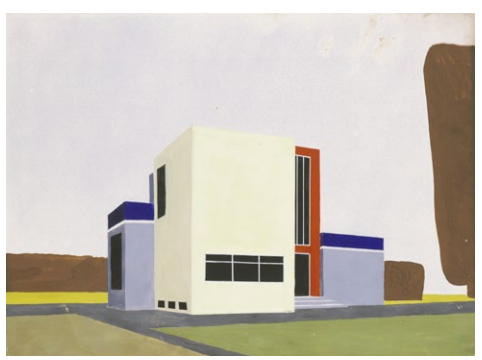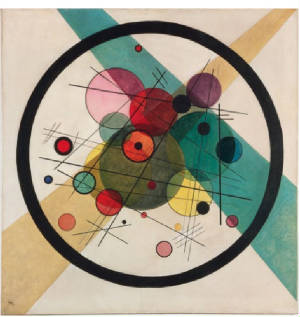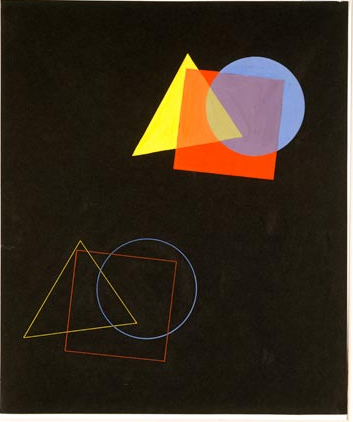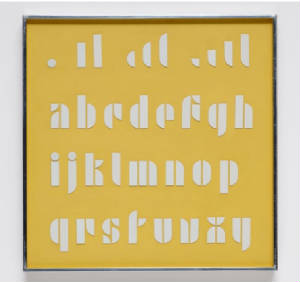|

Farkas Molnár
Design for a single-family house, 1922
Bauhaus-Archiv Berlin Photograph: Markus Hawlik
Bauhaus:
Art as Life
At the Barbican Art Gallery
By Anna Leung
A week after elections on March the 4th 1933 brought Hitler into power, the Weimar national
flag was replaced by the swastika and a temporary black, white and red flag. In the same year the Bauhaus which had been forced
out of Dessau and reduced to the status of a private educational establishment temporarily housed in a redundant telephone
factory in the suburbs of Berlin was closed by the Gestapo. Protracted talks between its head, Mies van der Rohe, and the
Gestapo eventually resulted in permission for the school to reopen. But Mies, who realised that in the light of Hitler’s
cultural ideology a Nazi Bauhaus was a contradiction in terms, promptly summoned what remained of his faculty and with their
unanimous assent voted to close it. The Bauhaus has
always been central to any discussion about relationships between art and politics. From its inception it was regarded as
the visual standard bearer of the Weimar Republic. The opening of the first Bauhaus in Weimar as the amalgamation of the Grand
Ducal Academy of Fine Art and the School of Arts and Crafts with Gropius as its head coincided with the setting up of the
new Weimar Republic. The frontispiece for Gropius’ ‘First Bauhaus Proclamation’, Feininger’s woodcut
The Cathedral of Socialism confirmed this view in the eyes of its right wing detractors, of which there were many.
Though not grounded in fact - the Bauhaus was reformist rather than revolutionary, in fact Gropius had been chosen for his
aristocratic and conservative bearing rather than his avant gardist leanings - a leftist reputation grew around it, and its
perceived bohemian, libertine life style had much to do with this.

Wassily
Kandinsky
Circles in a Circle, 1923
Philadelphia Museum of Art, The Louise and Walter Arensberg Collection,
1950
© ADAGP, Paris and DACS, London 2012
It is this emphasis on lifestyle that
this latest and largest exhibition on the Bauhaus seeks to explore and celebrate. Using the many photographic images that
record its fourteen year history this gutsy and lively exhibition has set out to capture the lifestyle of students (and staff)
with their many festivals and birthday celebrations, e.g. Klee’s 50th birthday when flowers and presents were dropped
from a plane on to his flat roof garden, and their experimental and innovative art and design work, and does so with a noteworthy
degree of success. It was in fact more than fortuitous that there were so many photographers documenting the many festivities
and fancy dress parties that punctuated the Weimar academic year. One of the groundbreaking shifts that the Bauhaus witnessed
was the move from craft to design with criteria of excellence no longer based on the painterly and expressionistic but on
technical and constructivist models. Photography, which only came to be recognised as a separate course in 1929, gradually
came to overshadow painting as the primary means of representation, a move that was signalled by the transformation of the
traditional print workshop that had concentrated on traditional woodcuts, etching and lithography, into the print and advertising
workshop under Moholy Nagy, who together with Gropius and Albers make up the seminal figures in this exhibition. That
this was a direction more in line with overtly commercial rather than ethical considerations was camouflaged in the early
years of the institution when Johannes Itten’s mystic beliefs took precedence despite the reservations that Gropius
must have harboured, and the antipathy to Itten’s student devotees, with their dedication to head shaving, ritual bathing,
purging and the vast consumption of garlic that his wife, the former Alma Mahler, took no trouble to hide. That the early history of the Bauhaus was characterised by this
spiritual and mystic element, personified in Itten who was in charge of the compulsory preliminary Vorkurs might seem to be
at variance with the modernist image that has grown up around the Bauhaus with its emphasis on simplification and economy
of form and its relation to function. But in its relatively short life span the school was constantly riven by internal conflicts,
craft contending with industry, expressionism with constructivism and the individual integrity of the artist pitted against
the drive for standardisation and efficiency. It is this dialectic that ultimately gave the institution its strength
and ensured its survival. Moreover, closing the school resulted in its ideas, ideals and pedagogic principles being disseminated
far beyond the Weimar Republic and finding fertile ground outside of Germany, especially in the US. Even if deferred, the
commercial principle had after all been at its core and the industrial components of design celebrated rather than masked.
That this had not seemed to be the case in its early years was due to necessity not to aspirations.

Eugen Batz The spatial effect of colours and forms, from Wassily Kandinsky's course at the Bauhaus Dessau, 1929. © VG Bild-Kunst,
Bonn, Germany / DACS 2012
Originally an attempt to reconcile the arts and crafts in the wake of the Great War when there was no industry
and no raw materials and returning to crafts made sense since there was no other option, in 1923 the school was given a new
orientation. Much like the leaders of other international modernist movements such as de Stijl in Holland and Le Corbusier’s
L’Esprit Moderne in France, Gropius realised that a new understanding of aesthetics, specifically of the relation between
the high and the applied arts, was needed if the powers of mechanisation and mass production were to be harnessed for the
good. But this could not be achieved overnight. Even before the war the machine tended to be demonised especially by artists
and poets. Rilke had given voice to a commonly held sentiment when he wrote that ‘all living things are threatened by
the machine.’ And this rejection of modernity was even more strident in the anarchic post-war period when the mass carnage,
the likes of which had never before been experienced, was attributed to the militarisation of the machine. It was Gropius’
resolution to transform this negative power into a potential for good. There is no doubt that this adoption of a new machine
aesthetic was motivated by a universalising, egalitarian democratic impetus, a belief that took on utopian dimensions in the
war weary and destabilised society that the new republic had as its goal to deal with. However, while recognising the need
for a new collective spirit that distanced itself from the rhetoric of individual self-expression Gropius never relinquished
his belief in the individual per se. He consistently argued that if there was a recognisable Bauhaus style it was determined
as much by the creative freedom of the individual student working within certain parameters as by the new possibilities afforded
by mechanised production. There was nothing new about these arguments. They had been raised
at many heated debates at the Deutscher Werkbund, a private association established in 1907 to integrate the arts and crafts
with industrial mass production. Described as ‘an association of the most intimate enemies’ it was made up of
architects, designers, craftsmen, industrialists and manufacturers, whose main aims were to combine educational with economic
priorities in order to affect a real cultural renewal, to educate a new public of consumers but above all else to compete
with and ultimately outrival England and France. It was here that Gropius would have met Henry van de Velde, the head of the
Weimar School of Art and Crafts who subsequently asked Gropius to take over the headship when he was forced, as an enemy alien,
to return to Belgium at the outbreak of the war. These discussions, it could be argued, were rehearsals for similar debates
regarding artistic originality versus industrial standardization that Gropius had to deal with as head of the Bauhaus. His
talent was to listen and to attempt to reconcile contending views; his forte was to hold opposing forces in a tensile balance
and it was this that made the Bauhaus an exciting forum of innovative ideas and exciting design. In 1923 the Preliminary course was taken over by Moholy Nagy and Albers, the first graduate
student to join the faculty. Itten had already seen to it that the traditional emphasis on drawing from classical casts was
replaced by exploratory exercises that emphasised basic materials and formal composition based on abstract elements such as
shape, line and colour. In this way students gained insights into the working possibilities of materials while also coming
to understand their own creative potential and so prove themselves sufficiently proficient to graduate to the next stage,
the individual workshops (metal, weaving, glass, print, book binding, murals, theatre and furniture). It was part of Gropius’
master plan that these were to be presided over by both a master of form, an artist, and a technical master of craft, thus
ensuring that aesthetics, understanding the relation between form and function, and practical skills went hand in hand. Indeed
Gropius urged all painters and sculptors to take up a craft and vice versa. Thus Klee was involved in weaving and Kandinsky,
who was in charge of the mural workshop, put much of his energies and imagination into theatre production. From the very beginning
the ultimate objective had been the great work of art, the Gesamtkunstwerk, that would involve all the different workshops
and which, till architecture became the hub of the school under Meyer and Mies, tended to gravitate around theatre production.
There was one exception and that was the Sommerfeld House. Built for a timber merchant this was the first opportunity for
the Bauhaus students to show what they could do. Influenced by Frank Lloyd Wright, the outside was sheathed with logs while
the interior was covered with teak panels taken from a redundant warship. Despite the fact that Bauhaus students made all
the windows, furniture and fixtures there was little that prefigured the Bauhaus look as we have come to know it; even Albers’
large glass windows were predominantly expressionist in style.

Josef
Albers
Bauhaus
lettering set, 1926-31
© The Josef and Anni Albers Foundation/Artists Rights Society (ARS), New York and DACS, London 2012
This was to change with Moholy Nagy’s
replacing Itten as the teacher of the Vorkurs, which signalled Gropius’ return to his long cherished ambition to weld
‘art and technology’ into ‘a new unity’ through the artistic application of technology to art and
design. The terrain for change had in effect already been prepared. In April 1921 Theo van Doesburg, a founder member of de
Stijl, had arrived in Weimar hoping to gain a teaching position in the Bauhaus. When this was not forthcoming - Gropius wisely
considered his ideas far too tendentious and rigidly theoretical – van Doesburg set up his own private course in Weimar.
This was to have a significant impact on the Bauhaus students, who defected in droves at a time when Itten and his devotees
were immersing themselves ever deeper into the cult of Mazdaznam. It was obvious that Itten had to be dismissed if the harmony
of the school was to be retained and its strengths consolidated. Finally, the 1923 exhibition that admittedly had been undertaken
reluctantly under pressure from the Thuringian state government to prove the school could earn its keep by producing industrially
manufactured goods was a success, and Gropius’ concept of ‘the new unity’ was able to show the way forward.
However more was needed and it was only when the school, which as a result of hostility on the part of the increasingly rightist
majority in the Weimar council, was forced to move to Dessau in 1926 that the new modernist Bauhaus came into existence and
Gropius was truly able to describe its work spaces as ‘laboratories in which prototypes of products suitable for mass
production and typical of our time are carefully developed and constantly improved.’
Photography and the adoption of a constructivist inspired typographical style
with its signature Bauhaus sans serif alphabet was widely used to promote these products through the setting up of a limited
company, Bauhaus GmbH (ltd), which was intended to act as sole agent for its products but which in fact was not sufficiently
business-like to deal with the real world. Royalties very seldom made their way back to the Bauhaus communal purse. There
were exceptions: lighting and wallpaper were both commercially successful, producing much needed income for the school. Another
success story was the setting up of the Bauhaus Verlag under the auspices of Gropius and Moholy Nagy which subsequently published
fourteen Bauhaus books including Klee’s Pedagogic Notebooks (sadly not in the exhibition) and Kandinsky’s
Point and Line to Plan; in this way the Bauhaus did much to disseminate the ideas that it shared with other international
modernist movements such as de Stijl, l’Esprit Moderne and Suprematism.
The radical changes in typography and presentation
that constituted a new identity prefigured the change of direction that came with the move to Dessau; the craft orientated
Bauhaus was transformed into the contemporary Bauhaus we still see mirrored in the modernist consumer goods that surround
us. Moholy Nagy was central to these changes. Like Kandinsky, he had been influenced by the Russian Constructivists and while
in no way as spiritual as Kandinsky his version of constructivism was likewise tempered by a great respect for artistic integrity.
Similarly, though he was committed to experimentation in photography and photomontage, which in his case had a distinct Dadaist
edge, and the first artist to produce an art work over the telephone, he never called for the relinquishing of all easel painting
and was in fact a practitioner himself who translated his fascination with the fourth dimension into beautiful abstract studies
of space, light and movement. This degree of tolerance and belief in diversity was important in an institution that was dominated
by painters of the stature of Klee and Kandinsky. Significantly, their singular pictorial languages, Kandinsky’s geometric
abstraction and Klee’s organic abstraction, conformed to a shared rejection of expressionistic gesture, which partly
explains why the Bauhaus has lasted and remains a contemporary presence whereas other modernist movements such as de Stijl
are chiefly of historic interest. Moholy Nagy left the Bauhaus in 1928, the same year as Gropius did, two years after the
move to Dessau saw the realisation of the latter’s pedagogic and architectural ideas. One can conjecture whether they
left because the job was done or whether they foresaw storm clouds ahead. Eventually, both made their way to the US where
they continued to disseminate Bauhaus ideas, Gropius at the Harvard Graduate School and Moholy Nagy opening The New Bauhaus
in Chicago which eventually became the Chicago Institute of Design.
Theatre was central to the Bauhaus and in many ways exemplified a life style
in which work, play and life on the campus all melded creatively together. Oskar Schlemmer was in charge of theatre workshop
from 1923 though Kandinsky, with Klee’s son Felix, who was a great puppeteer – you can see the highly imaginative
puppets his father made him - took on the design of sets and costumes for a performance of Mussorgsky’s Pictures
at an Exhibition. Schlemmer had already had a success in 1922 with his extremely innovative Triadic Ballet before
he had been invited to join the staff at the Bauhaus. A distinctly modernist ballet in three acts, it features three dancers,
two male and one female, whose bodies are encased in symmetrical geometric costumes made up of circles, spheres, triangles
and spirals. These severely impede the dancers’ movement, already limited by the fact that they can only perform frontally
or in profile. Schlemmer intended these geometric figures, from which all individual traits have been suppressed, to embody
a classic, universal image of man, man made whole by geometry. To reinforce this aim the whole ballet, the film of which
is unfortunately not part of the exhibition, is danced within a grid and against a blank backdrop. It is tempting to see the
stiff, stilted, puppet-like dancers as mirroring an increasingly mechanised epoch. But far more disturbing is the notion that,
with their mask like faces that are devoid of all individuality, they are impervious to whatever was happening around them.
Schlemmer was one of the few Bauhaus teachers who felt unable to emigrate but chose instead to go into an inner migration
living beyond the edge of society, shunned by the Nazi authorities, and dying in 1943 worn out by lack of recognition and
loneliness. Luckily, most of the Bauhaus staff (and hopefully their students) felt able to choose another option and made
new lives for themselves and in this way introduced a new way of living for generations to come.
The Barbican has not always proved
to be the most agreeable venue for displaying the visual arts. But with its succession of galleries alternating with corridor
space on its two levels, it is totally in harmony with this presentation of the Bauhaus, its history of art and craft featuring
on the upper level, and technology and design on the lower. Uniting both are the photos, many taken by both students’
and teacher’s wives (e.g. Lucia Moholy Nagy) that focus not on the austere modernist image of the Bauhaus but on the
centrality of play in the creative process. By concentrating on individuals rather than ideas and on images rather than theory
the Barbican has projected a new enduring image of the Bauhaus that, judging by the enthusiasm inspired in a whole range of
different age groups attending the exhibition, speaks to all generations.
|
